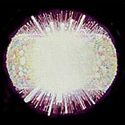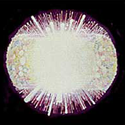Signs of a critical point
Several years ago, scientists at the Relativistic Heavy Ion Collider (RHIC) at Brookhaven National Lab in the US created a dense quark-gluon plasma from high-energy collisions between gold nuclei. Quantum Chromodynamics (QCD) predicts a critical point in the temperature vs density phase diagram of this dense matter, resulting from the restoration of chiral symmetry (see for example Ref. [1]). Below the critical point, the matter will naturally separate into two phases with different densities. The low-density phase exhibits spontaneous chiral symmetry breaking, whereas chiral symmetry is restored in the high-density phase. The distinction between the two phases disappears at the critical point, analogous to the liquid-gas phase transition in ordinary atomic and molecular systems.
Although both RHIC and the future Facility for Antimatter and Ion Research (FAIR) in Darmstadt, Germany, are planning experiments to search for evidence of the critical point, exactly what should be seen is not a priori clear. In a paper appearing in Physical Review C, Jørgen Radrup at Lawrence Berkeley National Laboratory in the US provides a careful and pedagogical analysis of the prospects for phase separation of bulk matter to occur in heavy-ion collisions. Randrup constructs an equation of state to model the QCD phase diagram, and a gradient term is included in the free energy to obtain a description of the interface between the two phases. This is applied to both ideal and viscous fluid dynamic descriptions of the matter to find the unstable modes in the region of phase separation. The probability of phase separation increases with the time spent in the unstable region, which could, in practice, be maximized by fine-tuning the beam energy.
Randrup’s results provide credible insight into the fascinating problem of critical behavior in dense nuclear matter. – Joseph Kapusta
[1] D. T. Son, Physics 2, 5 (2009).





